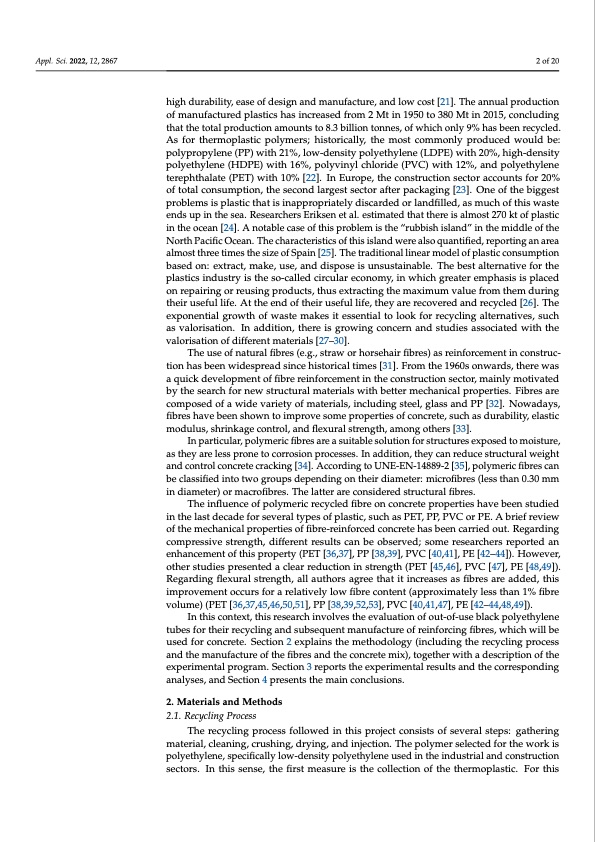
PDF Publication Title:
Text from PDF Page: 002
Appl. Sci. 2022, 12, 2867 2 of 20 high durability, ease of design and manufacture, and low cost [21]. The annual production of manufactured plastics has increased from 2 Mt in 1950 to 380 Mt in 2015, concluding that the total production amounts to 8.3 billion tonnes, of which only 9% has been recycled. As for thermoplastic polymers; historically, the most commonly produced would be: polypropylene (PP) with 21%, low-density polyethylene (LDPE) with 20%, high-density polyethylene (HDPE) with 16%, polyvinyl chloride (PVC) with 12%, and polyethylene terephthalate (PET) with 10% [22]. In Europe, the construction sector accounts for 20% of total consumption, the second largest sector after packaging [23]. One of the biggest problems is plastic that is inappropriately discarded or landfilled, as much of this waste ends up in the sea. Researchers Eriksen et al. estimated that there is almost 270 kt of plastic in the ocean [24]. A notable case of this problem is the “rubbish island” in the middle of the North Pacific Ocean. The characteristics of this island were also quantified, reporting an area almost three times the size of Spain [25]. The traditional linear model of plastic consumption based on: extract, make, use, and dispose is unsustainable. The best alternative for the plastics industry is the so-called circular economy, in which greater emphasis is placed on repairing or reusing products, thus extracting the maximum value from them during their useful life. At the end of their useful life, they are recovered and recycled [26]. The exponential growth of waste makes it essential to look for recycling alternatives, such as valorisation. In addition, there is growing concern and studies associated with the valorisation of different materials [27–30]. The use of natural fibres (e.g., straw or horsehair fibres) as reinforcement in construc- tion has been widespread since historical times [31]. From the 1960s onwards, there was a quick development of fibre reinforcement in the construction sector, mainly motivated by the search for new structural materials with better mechanical properties. Fibres are composed of a wide variety of materials, including steel, glass and PP [32]. Nowadays, fibres have been shown to improve some properties of concrete, such as durability, elastic modulus, shrinkage control, and flexural strength, among others [33]. In particular, polymeric fibres are a suitable solution for structures exposed to moisture, as they are less prone to corrosion processes. In addition, they can reduce structural weight and control concrete cracking [34]. According to UNE-EN-14889-2 [35], polymeric fibres can be classified into two groups depending on their diameter: microfibres (less than 0.30 mm in diameter) or macrofibres. The latter are considered structural fibres. The influence of polymeric recycled fibre on concrete properties have been studied in the last decade for several types of plastic, such as PET, PP, PVC or PE. A brief review of the mechanical properties of fibre-reinforced concrete has been carried out. Regarding compressive strength, different results can be observed; some researchers reported an enhancement of this property (PET [36,37], PP [38,39], PVC [40,41], PE [42–44]). However, other studies presented a clear reduction in strength (PET [45,46], PVC [47], PE [48,49]). Regarding flexural strength, all authors agree that it increases as fibres are added, this improvement occurs for a relatively low fibre content (approximately less than 1% fibre volume) (PET [36,37,45,46,50,51], PP [38,39,52,53], PVC [40,41,47], PE [42–44,48,49]). In this context, this research involves the evaluation of out-of-use black polyethylene tubes for their recycling and subsequent manufacture of reinforcing fibres, which will be used for concrete. Section 2 explains the methodology (including the recycling process and the manufacture of the fibres and the concrete mix), together with a description of the experimental program. Section 3 reports the experimental results and the corresponding analyses, and Section 4 presents the main conclusions. 2. Materials and Methods 2.1. Recycling Process The recycling process followed in this project consists of several steps: gathering material, cleaning, crushing, drying, and injection. The polymer selected for the work is polyethylene, specifically low-density polyethylene used in the industrial and construction sectors. In this sense, the first measure is the collection of the thermoplastic. For thisPDF Image | Recycled Polyethylene Fibres for Structural Concrete

PDF Search Title:
Recycled Polyethylene Fibres for Structural ConcreteOriginal File Name Searched:
applsci-12-02867.pdfDIY PDF Search: Google It | Yahoo | Bing
Development of a solar powered Electric Ship The Electricship website originally started off as a project to develop a comprehensive renewable, affordable, modular electric ship... More Info
Modular Boat Hull Composite The case for a unsinkable, modular composite hybrid boat hull... More Info
MS Burgenstock Hybrid Electric Catamaran Lake Lucerne Unique shuttle servicing Lucerne to the Burgenstock Resort... More Info
Ground Power Unit GPU Powered by Lithium Ion Batteries The goal of the Ground Power Unit is to provide a readily accessible, modular, ready-to-power solution for remote power... More Info
| CONTACT TEL: 608-238-6001 Email: greg@electricship.com | RSS | AMP |